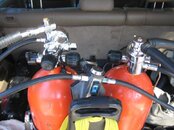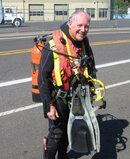EdTeach,
Thanks for your comments above. I've really enjoyed my AIR I, and have picked up a second AIR I second stage. Concerning the wet breathing, this happens when in an inverted position, and it can be annoying. The reason, I think, is that the diaphragm/exhaust valve (both the some) is held on at the bottom of the regulator. Most of the sealing surface that is potentially vulnerable to currents for the diaphragm are high up, and really away from the opening. I have had this regulator in high river currents without it affecting the exhaust at all. Because the diaphragm is held at the bottom, though, there is a few drops of water that are hard to expell totally from the regulator, and they manifest themselves when the diver is inverted (head down) and the water flows into the LP chamber, where it is pushed into the diver's mouth/throat on the next inhalation. These can be expelled by a sideways exhalation, but they will reappear because of breath condensation, if nothing else. So in the inverted position, it breaths wet. But it also breaths so easily, and smoothly!
The Dive/Predive switch does add about an inch of inhalation resistance, but my feeling is that this is mainly for snorkeling with the regulator out of the mouth, and it does prevent free flows. It can also be used as a safe second, with this switch in the Predive position, and it will not free flow.
Finally, the Pilot and the AIR I are the only regulators that I know of that accept two LP lines, one on each side. This maximized the pool of LP air at the regulator for really deep or strenuous dives. It can also be used as a safety feature by providing for independent doubles which are hooked into a single second stage. The photos show a setup I made using the AIR I with Scubapro and Dacor Oylmpic first stages feeding it.
SeaRat






